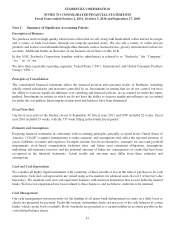Starbucks 2011 Annual Report Download - page 54
Download and view the complete annual report
Please find page 54 of the 2011 Starbucks annual report below. You can navigate through the pages in the report by either clicking on the pages listed below, or by using the keyword search tool below to find specific information within the annual report.Short-term and Long-term Investments
Our short-term and long-term investments consist primarily of investment grade debt securities, including some
auction rate securities, all of which are classified as available-for-sale. Also included in our available-for-sale
investment portfolio are certificates of deposit placed through an account registry service. Available-for-sale
securities are recorded at fair value, and unrealized holding gains and losses are recorded, net of tax, as a component
of accumulated other comprehensive income. Available-for-sale securities with remaining maturities of less than
one year and those identified by management at the time of purchase to be used to fund operations within one year
are classified as short term. All other available-for-sale securities, including all of our auction rate securities, are
classified as long term. Unrealized losses are charged against net earnings when a decline in fair value is determined
to be other than temporary. We review several factors to determine whether a loss is other than temporary, such as
the length and extent of the fair value decline, the financial condition and near term prospects of the issuer, and
whether we have the intent to sell or will likely be required to sell before the securities anticipated recovery, which
may be at maturity. Realized gains and losses are accounted for using the specific identification method. Purchases
and sales are recorded on a trade date basis.
We also have a trading securities portfolio, which is comprised of marketable equity mutual funds and equity
exchange-traded funds. Trading securities are recorded at fair value with unrealized holding gains and losses
included in net earnings.
Fair Value
Fair value is the price we would receive to sell an asset or pay to transfer a liability (exit price) in an orderly
transaction between market participants. For financial instruments and investments that we record or disclose at fair
value, we determine fair value based upon the quoted market price as of the last day of the fiscal period, if
available. If a quoted market price is not available for identical assets, we determine fair value based upon the
quoted market price of similar assets or using a variety of other valuation methodologies. We determine fair value of
our auction rate securities using an internally developed valuation model, using inputs that include interest rate
curves, credit and liquidity spreads, and effective maturity.
The carrying value of cash and cash equivalents approximates fair value because of the short-term nature of these
instruments. The fair value of our long-term debt is estimated based on the quoted market prices for the same or
similar issues or on the current rates offered to us for debt of the same remaining maturities.
We measure our equity and cost method investments at fair value on a nonrecurring basis when they are determined
to be other-than temporarily impaired. Fair values are determined using available quoted market prices or discounted
cash flows.
Derivative Instruments
We manage our exposure to various risks within the consolidated financial statements according to an umbrella risk
management policy. Under this policy, we may engage in transactions involving various derivative instruments,
with maturities generally not longer than five years, to hedge interest rates, commodity prices and foreign currency
denominated revenues, purchases, assets and liabilities.
We record all derivatives on the balance sheets at fair value. For a cash flow hedge, the effective portion of the
derivative’s gain or loss is initially reported as a component of other comprehensive income (“OCI”) and
subsequently reclassified into net earnings when the hedged exposure affects net earnings. For a net investment
hedge, the effective portion of the derivative’s gain or loss is reported as a component of OCI.
Cash flow hedges related to anticipated transactions are designated and documented at the inception of each hedge
by matching the terms of the contract to the underlying transaction. We classify the cash flows from hedging
transactions in the same categories as the cash flows from the respective hedged items. Once established, cash flow
hedges are generally not removed until maturity unless an anticipated transaction is no longer likely to occur. For
discontinued or dedesignated cash flow hedges, the related accumulated derivative gains or losses are recognized in
net interest income and other on the consolidated statements of earnings.
48
























